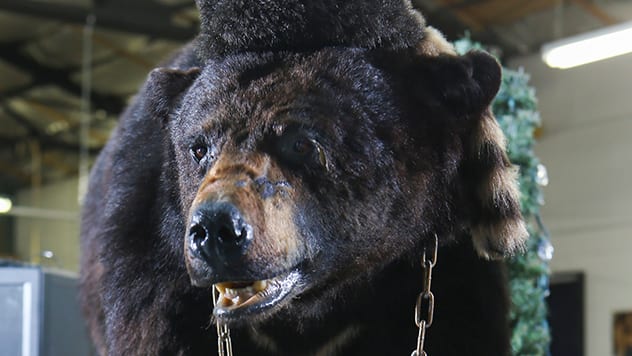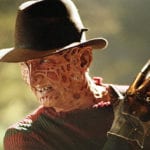 History
History  History
History  Creepy
Creepy 10 More Representations of Death from Myth, Legend, and Folktale
 Technology
Technology 10 Scientific Breakthroughs of 2025 That’ll Change Everything
 Our World
Our World 10 Ways Icelandic Culture Makes Other Countries Look Boring
 Misconceptions
Misconceptions 10 Common Misconceptions About the Victorian Era
 Mysteries
Mysteries 10 Strange Unexplained Mysteries of 2025
 Miscellaneous
Miscellaneous 10 of History’s Most Bell-Ringing Finishing Moves
 History
History 10 Great Escapes That Ended Right Back in Captivity
 Weird Stuff
Weird Stuff 10 Fascinating Things You Might Not Know About Spiders
 Food
Food 10 Everyday Foods You Didn’t Know Were Invented by the U.S. Military
 History
History 10 Most Influential Protests in Modern History
 Creepy
Creepy 10 More Representations of Death from Myth, Legend, and Folktale
 Technology
Technology 10 Scientific Breakthroughs of 2025 That’ll Change Everything
Who's Behind Listverse?

Jamie Frater
Head Editor
Jamie founded Listverse due to an insatiable desire to share fascinating, obscure, and bizarre facts. He has been a guest speaker on numerous national radio and television stations and is a five time published author.
More About Us Our World
Our World 10 Ways Icelandic Culture Makes Other Countries Look Boring
 Misconceptions
Misconceptions 10 Common Misconceptions About the Victorian Era
 Mysteries
Mysteries 10 Strange Unexplained Mysteries of 2025
 Miscellaneous
Miscellaneous 10 of History’s Most Bell-Ringing Finishing Moves
 History
History 10 Great Escapes That Ended Right Back in Captivity
 Weird Stuff
Weird Stuff 10 Fascinating Things You Might Not Know About Spiders
 Food
Food 10 Everyday Foods You Didn’t Know Were Invented by the U.S. Military
Top 10 Wilderness Horror Movies Based On Horrific True Stories
In the wilderness, we have little control over our surroundings, and, whether a provincial park, a rain forest, a crocodile-infested area along a flooded river, or another forbidding location, our environment can be hostile, dangerous, or even deadly.
Trees obscure lines of sight; darkness impedes vision; sounds in the darkness seem ominous. Especially in remote locations, the wilderness isolates us, cutting us off from civilization and the assistance that social institutions and government agencies could otherwise provide. No ambulances, fire trucks, or police cruisers are standing by; no emergency telephone operators await our calls; no infrastructure of highways, hospitals, and other resources is available.
In movies that combine horror with wilderness environments, characters are likewise vulnerable and helpless. They are alone, in the dark, among wild animals or other threats. They may find themselves in the presence of killers, some of whom could be family members or friends. These 10 wilderness horror movies based on horrific true stories may make us think twice about power outages, camping, traveling, or even staying home alone.
Top 10 Classic Horror Movie Misconceptions
10 Razorback
Based on Peter Brennan’s novel of the same title, Russell Mulcahy’s 1984 film Razorback features opening footage that alludes to the investigation of the murder of Azaria Chamberlain, who was allegedly carried off and devoured by a dingo.
On August 16, 1980, as the Chamberlain family enjoyed dinner with other campers who had set up in an Uluru campsite near Ayer’s Rock, they heard their infant daughter scream. The child’s bassinet, which was situated just inside the opening of their tent, was empty: baby Azaria was missing! Searchers discovered a trail of paw marks accompanied by marks of the bassinet, but Azaria was not found.
When the Chamberlains, Seventh-Day Adventists mistaken for Jehovah’s Witnesses, returned home, rumors spread that they had sacrificed their daughter to atone for the world’s sins or because she was the devil’s child. Denis Barritt, the coroner, sought to dispel these wild stories, but he was replaced by Coroner Jerry Galvin, and Barritt’s findings were overturned.
The baby’s mother, Lindy, was tried, found guilty, and spent two years in prison before she was released. A review of her case by a Royal Commission found that laboratory findings had been misrepresented or falsified. For example, Azira’s “blood,” found in the family’s car, turned out to be the remnants of a “spilled milkshake,” and the baby’s “blood” on nail scissors was identified as the “industrial chemical, Dufiz 101, sprayed on during manufacture.” The Northern Territory Supreme Court “fully exonerated” Lindy and her husband Michael.
The parallels to the Chamberlain’s horrific experience and that of the film’s protagonist, Jake Cullen (Bill Kerr), are clear. While he babysits his grandson at his home in the Australian Outback, a razorback boar breaks into the house, making off with the child to devour. Charged with murdering the child, Jake is finally acquitted due to a lack of evidence. The movie’s plot then takes a direction of its own, as Jake seeks vengeance against the razorback, blaming the boar for the destruction of his reputation, borrowing now, perhaps, from Herman Melville’s Moby Dick.
9 Alive
Directed by Frank Marshall, Alive (1993) recounts the horrific ordeal experienced by a rugby team and the player’s family members and friends as they fly to a match in Chile. The movie, based on Piers Paul Read’s 1974 book Alive: The Story of the Andes Survivors, is horrifying, but the actual incidents on which the film is based are even ghastlier and more horrendous.
Not much of their plane survived the crash into the Andes that occurred on Friday the 13th, October 1972. Lying on its side on the snow-covered mountainside, its nose crumpled, its wings sheared off, and its tail pulverized, the remains of the fuselage were smashed and dented.
Roberto Canessa, another surviving member of the rugby team, also wrote an account of the ordeal. In his own book, I Had to Survive,
he recalled the “irreversible” decision that he and three others made, a choice that cost them their “innocence.” Cut off from “vegetation” and “animal life,” the survivors “lacked food,” he reported, although they “knew the answer”: “The bodies of our friends and team-mates, preserved outside in the snow and ice, contained vital, life-giving protein that could help us survive.” Nevertheless, they resisted: “It was too terrible to contemplate.”
Finally, nine days following the crash, hunger persuaded them. “I will never forget that first incision nine days after the crash,” Canessa declared, explaining how he and the other three men cut “thin strips of frozen flesh” from the dead and “laid [them] aside on a piece of sheet metal” to be claimed and consumed when each of the men “could bear to” do so.
Twenty-seven of the 45 passengers aboard the ill-fated aircraft survived the crash, but an avalanche killed an additional eight. The slide also carried off the dead, upon whose flesh the men had been feeding. Canessa recalled steeling himself “to do what needed to be done,” as he decided “to use one of the bodies of the newly dead.”
The survivors were not rescued until December 23, seventy-two days after the airplane’s crash. At home again, Canessa confessed, “Mother, we had to eat our dead friends.” “That’s okay, that’s okay, sweetie,” she replied. The son also told his father that he would next inform the families of those he’d eaten of his deed. To his surprise, Canessa found them to be understanding and “supportive.”
Now a pediatric cardiologist, Canessa attributes his survival to his family and his desire to see them again.
8 Cabin Fever
An eruption of psoriasis resulting in “cracked and bleeding” legs that made walking impossible and a later infection on his face, resulting in his shaving “off chunks of [his] face,” made Eli Roth, the director of Cabin Fever (2002), realize that “weird things . . . can happen to your body.” These unsettling experiences also helped him to realize that a similar infection “would be a great idea for a horror movie.” The result was Cabin Fever, which involves a flesh-eating virus.
Since the movie is a horror film, audiences know something horrific will happen, but the infection of a hermit who stumbles upon a dead dog and becomes a bloody, disfigured mess as a result is also certainly a clue that disgusting and terrible incidents are at hand, especially when the hermit vomits blood during a visit to the cabin of college students vacationing in the deep woods. When one of the vacationers, Karen, develops an infection between her legs, the audience receives another clue that things are probably going to get much worse before they get better, if they get better.
7 Wolf Creek
Wolfe Creek National Park in the Western Australian Outback is the setting for the movie Wolf Creek (2005) directed by Greg McLean. British tourists Liz Hunter (Cassandra Magrath) and Kristy Earl (Kestie Morassi) and their Australian friend Ben Mitchell (Nathan Phillips) are victimized by Mick Taylor (John Jarratt), who poses as a good Samaritan after the trio’s car fails on the Great Northern Highway, leaving them stranded.
In reality, as Joanne Lees points out in her autobiographical account of her horrific ordeal, No Turning Back: My Journey, the movie’s British tourists were Peter Falconio and Lees herself, who were traveling the Stuart Highway at night, 2,000 kilometers from Wolfe Creek National Park. They were between Alice Springs and Darwin when a mechanic, Bradley John Murdoch, pulled them over to advise them that their vehicle’s exhaust was throwing sparks. Murdoch shot Falconio and bound Lees, placing her in his own four-wheel-drive vehicle, while he concealed Falconio’s body. She escaped, staying hidden in the bush until Murdoch gave up looking for her. Later, she was assisted by two truck drivers, after she’d walked back onto the highway. Murdoch was subsequently arrested, tried, convicted, and sentenced to serve from 28 years to life in prison.
The movie’s Mick Taylor is also based on serial killer Ivan Milat, who, during the 1990s, took hitchhikers whom he picked up in New South Wales into the Belango State Forest, where he tortured and killed them. McLean added elements of the actual cases involving Murdoch, Lees, Falconio, Milat, and Milat’s victims only after he’d learned of them, following his writing of his film’s original script. Art imitates life, it seems—and vice versa.
6 Turistas
Director John Stockwell’s warning to potential cast members of his upcoming film Turistas (2006) indicated the discomforts and potential dangers they would face in the wilderness if they signed on to star in the movie, which was to be shot on location in the rain forests of Brazil. The actors’ home would be a tent. Their chairs would be rocks. They’d wade through water polluted with bat excrement. They’d probably be injured, although, he added, it was highly unlikely any of them would die.
A bizarre incident that occurred to Stockwell during a surfing expedition in Peru interested him in directing Turistas. He’d been “robbed,” he said, “by a group of 13-year-old, glue-sniffing kids and had been shot at.” When he reported the incident to the local police, they said he could “kill” his attackers in exchange for $300. Upon his return to the United States, he read the script for Turistas, and “it resonated” with him, he said.
In the movie itself, American tourists Alex (Josh Duhamel), his sister Bea (Olivia Wilde), and Bea’s friend Amy (Beau Garrett) are backpacking through Brazil when they’re joined by British men Finn (Desmond Askew) and Liam (Max Brown). Drugged during a party, they awaken stranded on a deserted beach, the latest turistas to become part of a heinous black-market enterprise.
5 Backcountry
Possibly, the black bear wandering a provincial park in northern Ontario, Canada, had developed a taste for human flesh and blood. The animal attacked Jacqueline Perry while she was camping with her husband Mark Jordan eighty kilometers north of Chapleau. He fought back, stabbing the predator with his Swiss Army knife, before the bear could drag his wife further into the deep woods.
Jordan carried his badly injured wife to their kayak and paddled to the closest campsite, where he was assisted by a father and son from Pennsylvania who were visiting the park. Unfortunately, although a North Carolina doctor treated Perry aboard the Pennsylvanians’ boat, Perry did not survive the ordeal.
The couple’s horrific experience inspired the movie Backcountry (2014) directed by Adam MacDonald. In the film, thanks to Alex (Jeff Roop), he and his girlfriend Jen (Missy Peregrym), a lawyer, get lost during a weekend camping trip to a provincial park, and Alex fights a bear, allowing Jen to escape. The bear kills and devours him, but she lives, finds her way back to the shore of the lake where she and Alex beached their canoe, and paddles across a lake to a group of tourists and their guide. Although she has broken her leg in a fall and is much the worse, emotionally and physically, she survives, unlike Alex.
MacDonald was inspired by Open Water (2003), in which a couple are attacked by sharks after they are stranded at sea. He wanted Backcountry to be an “Open Water in the woods,” he said. However, rather than having Jen be attacked and killed by the bear, he made Alex the victim because he wanted to show the experience that caused Jen to become a strong woman. In the film, he said, audiences “can actually see the moment where she becomes strong and faces life for what it is.” The test of her ordeal was a test of her character, and her survival proved her mettle, MacDonald suggests.
Gov. Gen. Michaëlle Jean was so impressed by Jordan’s bravery that she awarded him the Star of Courage for protecting Perry in an attempt to save her life at the risk of losing his own, during which attempt he received wounds requiring 300 stitches. The governor said that the award is reserved for “acts of conspicuous courage in circumstances of great peril.”
4 Bodom
Directed by Taneli Mustonen, the Finnish film Bodom (2016) concerns four young adults who camp near Lake Bodominjärvi in Espoo, a city in Finland’s Uusimaa region. The director, who had grown up in Outokumpu, thought the events surrounding a murder mystery constituted an intriguing story, but he also saw a problem with making such a film. How could he make “a universal topic,” such as “young people camping,” offer audiences “something new”? Visiting “the scene when the murder trial was reopened in 2004,” he found his answer: “I went there on a trek during the trial and noticed that there were young people out there looking for that same headland. That’s when I got the idea for the movie.”
In the film, friends, Nora, Elias, Atte, and Ida, go camping near Lake Bodom, as Lake Bodominjärvi is called. They aren’t just vacationing, though: they want to reconstruct the murders that occurred there in 1960. Unfortunately, they themselves encounter a killer. Interesting twists follow, although the ending of the film may strain its audience’s credulity.
3 Black Water
Black Water (2018), written and directed by Andrew Traucki and David Nerlich, is set in an Australian mangrove swamp, the home of hungry crocodiles. During a vacation, Grace (Dianna Glenn), her husband Adam (Andy Rodoreda), and Grace’s sister Lee (Maeve Dermody), take in a crocodile show. The next day, during a fishing trip, a crocodile capsizes the boat they’ve rented, and their armed guide (Ben Oxenboul) is killed, leaving the hapless vacationers alone with the swamp’s top predator and no help in sight.
According to an article in The Guardian, “The Wet,” located in Australia’s Northern Territory, is notorious for the occurrence of “tropical cyclones, monsoon rains, and stifling humidity,” its downpours frequently flooding the Finniss River and turning dry land to mud and “partially submerging . . . trees.” The area’s crocodiles have killed as many as a dozen people, including tourists, over the last two decades, and the reptiles’ attacks are the basis of Black Water’s storyline. However, as the Guardian’s article points out, although Black Water “claims to be ‘based on true events,’” it is, in reality, merely a “monster” movie, the “horror” of which does not approach that of the actual victims’ anguish and terror.
2 Cocaine Bear

Cocaine Bear hasn’t been made yet. Its production is scheduled for the summer of 2021. The movie’s script is based on a 1980 incident: a parachuting drug smuggler, finding it necessary to lighten his load, dropped bags of cocaine as he drifted over Georgia, and a 175-pound black bear helped itself to the unexpected treat, dying as a result of an overdose.
A few months later, a hunter found the bear dead in the Chattahoochee National Forest in Georgia, its belly “literally packed to the brim with cocaine,” according to the animal’s autopsy, and the bear suffered “cerebral hemorrhaging, respiratory failure, hypothermia, renal failure, heart failure, [and] stroke.” The ursine victim was stuffed and sold to various owners, including country singer Waylon Jennings. In 2015, the animal was on display, under the name Pablo Escobear, at the Kentucky Fun Mall. Soon, greater exposure will follow, with the premiere of Cocaine Bear!
The bizarre event attracted the attention of producers Phil Lord and Chris Miller, who plan to produce the movie as part of their deal with Universal Pictures. Elizabeth Banks will direct.
1 The Widow
Due in the spring of 2021, The Widow, directed by Svyatoslav Podgaevsky, is set in a thick forest north of St. Petersburg, Russia, where people have been disappearing for thirty years, often without a trace, and the few bodies that have been found were invariably naked. Now that a teenage girl has vanished, volunteers search for her among the dense trees and brush. Mysteriously, they lose communication with one another, leading the local population to wonder whether this strange incident is further work of the Limping Widow’s spirit.
The movie, starring Viktotiya Potemina, Anastasiya Gribova, and Margarita Bychkova, is based on the strange fact that 300 people each year actually do go missing in this part of the country. As in the film, when the bodies of the dead are discovered, they are sometimes naked and bear no signs of violence. Ironically, the crew began filming on October 14, 2018, the Holy Virgin’s Day, when, folklore claims, the forest becomes a deadly location. As far as we know, folklore doesn’t account for the corpses’ nudity, however. The picture is scheduled for North American release on digital, on-demand, DVD, and Blu-Ray in March 2021.
Top 10 Must-See Recent Genre-Defying Horrors
About The Author: An English instructor at the University of Nevada Las Vegas, Gary L. Pullman lives south of Area 51, which, according to his family and friends, explains “a lot.” His four-book series, An Adventure of the Old West, is available on Amazon.








